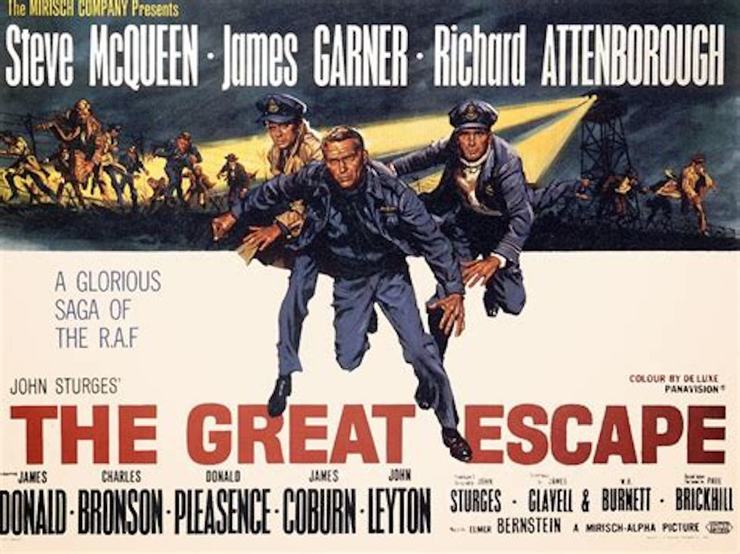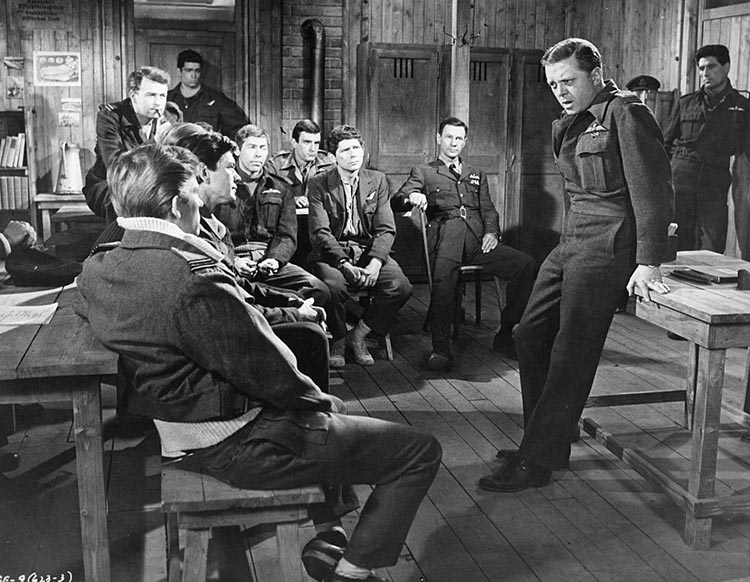There's Always a Way
If there’s one aspect of the story of the Great Escape that appeals most to the masculine heart, it’s the way it exemplifies the qualities of manly camaraderie.

Capital Thinking • Issue #686 • View online
When people in the UK were polled as to what movie they would most like to watch on Christmas Day, the number one choice among male respondents was The Great Escape.
The classic 1963 film depicting the unbelievable breakout of 76 prisoners from a German POW camp during WWII has long held an inviolable place in any library of essential movies for men.
It’s a film fathers like to share with their families, and husbands like to enjoy by themselves while their wives are off on a weekend trip.
-Brett and Kate McKay
Why Men Love the Story of the Great Escape
Brett and Kate McKay | Art of Manliness:
Part of The Great Escape’s appeal to men is obvious: it’s got a wartime setting, action, suspense, a crackerjack cast that includes James Garner, Charles Bronson, and Steve McQueen, and, of course, one of the greatest cinematic motorcycle stunts of all time.
But the draw runs deeper, to the elements of the story itself, which though fictionalized in some respects, contain many details that are true to the real events on which the film is based.
Digging into these elements common to both the cinematic and historical Great Escape reveals why the story resonates so much with men, and offers a window on the landscape of the masculine heart.
Intolerance for Subjection
Stalag Luft III, a prisoner-of-war camp located deep in Nazi-occupied Poland, housed thousands of Allied airmen who had fallen into German hands.
Constructed with barrack blockhouses that were raised on stilts (to enable guards to keep an eye on tunneling attempts); built atop sandy soil (to make it easy to spot the darker soil produced through excavation); and surrounded with seismographic microphones (to pick up on the vibrations created by digging), two barbed-wire-topped fences, and numerous watchtowers equipped with high-beam spotlights and gun-wielding sentries, the camp was considered “escape proof.”
There also existed a psychological factor that perhaps worked against escape attempts to an even greater extent than these physical impediments.
Rather than being the kind of cruel, hardship-ridden camp from which men would be desperate to flee, the conditions at Stalag Luft III were in fact fairly hospitable.
The prisoners were not tortured or mistreated. Their rations were decent (at least when combined with the foodstuffs which arrived in the Red Cross care packages they were allowed to receive). Barracks were spartan but snug and sanitary.
Robust recreational opportunities were offered, from playing in bands and orchestras, to performing in biweekly musicals and plays, to reading books in the library, to participating in debating societies, art classes, and games of basketball, softball, and football.
The camp wasn’t the Hilton, and simply being detained in the same spot for several years could drive a man mad, but it wasn’t the most onerous place to bide one’s time.
This was by the Germans’ design.
Stalag Luft III was run by the Luftwaffe, which had a culture that elevated gentlemanly respect between all fellow air force officers — even those belonging to the opposing side — and a commandant in Friedrich Wilhelm von Lindeiner who despised the Nazi regime and sympathized with his prisoners.
Von Lindeiner not only treated his inmates well out of a sincere sense of chivalry, but in the belief that making them comfortable would sap their desire for escape, contenting them to wait out the rest of the war from behind the walls of the camp.
While some prisoners were indeed placated, a significant contingent was not.
They knew that an escape would take incredible effort, and put their lives at risk; though the Geneva Conventions protected recaptured POWs from being killed, the prisoners understood there was a chance the Nazis might not play by the rules (and indeed, 50 of the 76 who made it out in the Great Escape were summarily executed by an enraged Hitler’s direct order).
Nevertheless, these airmen took seriously their duty as military officers to break out, and saw escape attempts as an extension of the Allied war effort.
POW camps already diverted significant money and manpower from the enemy, and escapes, and the wide-scale searches they set off, tied up even more resources amongst the German military, police forces, and the civilian population at large.
We often think of the sole goal of the prisoners’ escapes as making it all the way home, and of course that was their fondest desire. But in fact, the prisoners knew that with the number of police and Gestapo checkpoints and the difficulty of being on the lam in Nazi-occupied territory, achieving a “home run” escape was extremely unlikely.
The point wasn’t to get back; it was, as prisoner Mike Shand put it, to “cause chaos behind enemy lines.”
For Squadron Leader Roger Bushell, mastermind of the Great Escape plot, prisoners were honor-bound to “harass, confuse, and confound the enemy,” and to play no safer with their lives than soldiers did on the battlefront.
Regardless of whether their cages were gilded, he and his fellow troublemakers chafed at being confined, and were committed to continuing their fight from behind bars. Very committed, in fact; the famous Great Escape plot and the three tunnels constructed for it (codenamed “Tom”, “Dick,” and “Harry”), was in fact just one of 262 escape attempts, involving 100 other tunnels, which were undertaken from inside the camp.
As Tim Carroll puts it in The Great Escape from Stalag Luft III, the escape-plotters were “an indomitable clan of adventure- and life-loving characters who all refused to accept captivity and were prepared to do anything to cock a snook at those who would oppress them.”
Men cheer the will of such characters to resist authority out of a shared hatred for being put under anyone’s thumb (hence the reason we often can’t help rooting for a prisoner who escapes from jail, despite the fact they’re a convicted criminal; we instinctively side with the guy fleeing any kind of subjection, even if deserved!).
Escape can be a literal thing, but it also carries much metaphorical weight; all of us feel a yearning to escape from the past, from the strictures of conformity, from external and self-imposed limits.
What resonates with the manly heart all the more, is the Great Escapers’ underdog status; here was the archetypical David and Goliath story, in which those in power, who had all the obvious advantages, were outwitted through the sheer force of human ingenuity.
Told it couldn’t be done, that escape wasn’t possible, the scrappers pulled it off anyway.
How our spirits are lifted by the idea that no matter what, there’s always a way out!

